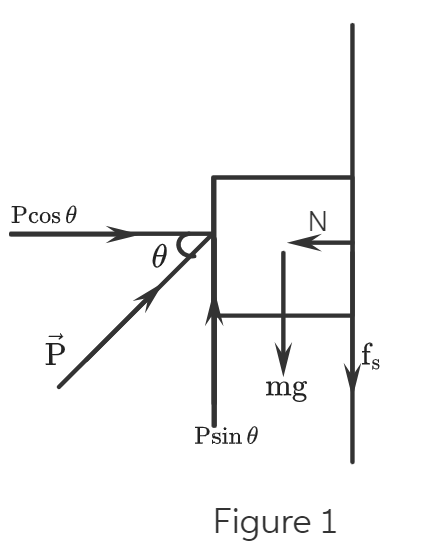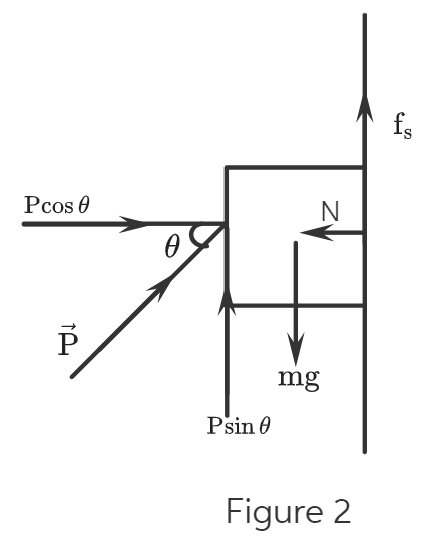A block of mass 5.40 kg is pushed up against a wall by a force P that makes an angle of = 50.0° angle with the horizontal as shown below. The coefficient of static friction between the block and the wall is 0.300. (a) Determine the possible values for the magnitude of P that allow the block to remain stationary. (If there is no maximum, enter NONE in that answer blank.) P maxl= = 92.32 IP min' Your response differs from the correct answer by more than 10%. Double check your calculations. N (b) What happens if IP has a larger value than IP The block slides up the wall. O The block does not slide along the wall. O The block slides down the wall. P What happens if |P| has a smaller value than IP The block slides up the wall. The block does not slide along the wall. The block slides down the wall. P max N IP (c) Repeat parts (a) and (b) assuming the force makes an angle of = 12.0° with the horizontal. Determine the possible values for the magnitude of P that allow the block to remain stationary. (If there is no maximum, enter NONE in that answer blank.) N |= min! = What happens if IP has a larger value than IP The block slides up the wall. The block does not slide along the wall. O The block slides down the wall. maxl? min!? max!? What happens if IP has a smaller value than IP O The block slides up the wall. O The block does not slide along the wall. The block slides down the wall. min!?
A block of mass 5.40 kg is pushed up against a wall by a force P that makes an angle of = 50.0° angle with the horizontal as shown below. The coefficient of static friction between the block and the wall is 0.300. (a) Determine the possible values for the magnitude of P that allow the block to remain stationary. (If there is no maximum, enter NONE in that answer blank.) P maxl= = 92.32 IP min' Your response differs from the correct answer by more than 10%. Double check your calculations. N (b) What happens if IP has a larger value than IP The block slides up the wall. O The block does not slide along the wall. O The block slides down the wall. P What happens if |P| has a smaller value than IP The block slides up the wall. The block does not slide along the wall. The block slides down the wall. P max N IP (c) Repeat parts (a) and (b) assuming the force makes an angle of = 12.0° with the horizontal. Determine the possible values for the magnitude of P that allow the block to remain stationary. (If there is no maximum, enter NONE in that answer blank.) N |= min! = What happens if IP has a larger value than IP The block slides up the wall. The block does not slide along the wall. O The block slides down the wall. maxl? min!? max!? What happens if IP has a smaller value than IP O The block slides up the wall. O The block does not slide along the wall. The block slides down the wall. min!?
College Physics
11th Edition
ISBN:9781305952300
Author:Raymond A. Serway, Chris Vuille
Publisher:Raymond A. Serway, Chris Vuille
Chapter1: Units, Trigonometry. And Vectors
Section: Chapter Questions
Problem 1CQ: Estimate the order of magnitude of the length, in meters, of each of the following; (a) a mouse, (b)...
Related questions
Question

Transcribed Image Text:A block of mass 5.40 kg is pushed up against a wall by a force P that makes an angle of = 50.0° angle with the horizontal as shown below. The
coefficient of static friction between the block and the wall is 0.300.
(a) Determine the possible values for the magnitude of P that allow the block to remain stationary. (If there is no maximum, enter NONE in
that answer blank.)
P.
maxl=
IP
A
N
X
Your response differs from the correct answer by more than 10%. Double check your calculations. N
P
Pminh,
= 92.32
(b) What happens if IP has a larger value than IP
The block slides up the wall.
The block does not slide along the wall.
The block slides down the wall.
|Pmaxl =
P
min! =
What happens if IP has a smaller value than IP min!?
The block slides up the wall.
O The block does not slide along the wall.
The block slides down the wall.
(c) Repeat parts (a) and (b) assuming the force makes an angle of = 12.0° with the horizontal. Determine the possible values for the
magnitude of P that allow the block to remain stationary. (If there is no maximum, enter NONE in that answer blank.)
max!?
N
What happens if IP has a larger value than IP
The block slides up the wall.
The block does not slide along the wall.
The block slides down the wall.
/?
max
What happens if |P| has a smaller value than IP
min!?
The block slides up the wall.
The block does not slide along the wall.
The block slides down the wall.
Expert Solution
Step 1: Introduction
Given data:
The mass of the block:
The angle of the force withe the horizontal:
The cofficient of static friction between the block and the wall:
Free-body diaram:
If the block has tendency to move upwards-

If the block has tendency to move downwards-

Here,
is the normal force,
is the acceleration due to gravity, and
is the force due to static friction.
Trending now
This is a popular solution!
Step by step
Solved in 5 steps with 30 images

Knowledge Booster
Learn more about
Need a deep-dive on the concept behind this application? Look no further. Learn more about this topic, physics and related others by exploring similar questions and additional content below.Recommended textbooks for you

College Physics
Physics
ISBN:
9781305952300
Author:
Raymond A. Serway, Chris Vuille
Publisher:
Cengage Learning

University Physics (14th Edition)
Physics
ISBN:
9780133969290
Author:
Hugh D. Young, Roger A. Freedman
Publisher:
PEARSON

Introduction To Quantum Mechanics
Physics
ISBN:
9781107189638
Author:
Griffiths, David J., Schroeter, Darrell F.
Publisher:
Cambridge University Press

College Physics
Physics
ISBN:
9781305952300
Author:
Raymond A. Serway, Chris Vuille
Publisher:
Cengage Learning

University Physics (14th Edition)
Physics
ISBN:
9780133969290
Author:
Hugh D. Young, Roger A. Freedman
Publisher:
PEARSON

Introduction To Quantum Mechanics
Physics
ISBN:
9781107189638
Author:
Griffiths, David J., Schroeter, Darrell F.
Publisher:
Cambridge University Press

Physics for Scientists and Engineers
Physics
ISBN:
9781337553278
Author:
Raymond A. Serway, John W. Jewett
Publisher:
Cengage Learning

Lecture- Tutorials for Introductory Astronomy
Physics
ISBN:
9780321820464
Author:
Edward E. Prather, Tim P. Slater, Jeff P. Adams, Gina Brissenden
Publisher:
Addison-Wesley

College Physics: A Strategic Approach (4th Editio…
Physics
ISBN:
9780134609034
Author:
Randall D. Knight (Professor Emeritus), Brian Jones, Stuart Field
Publisher:
PEARSON